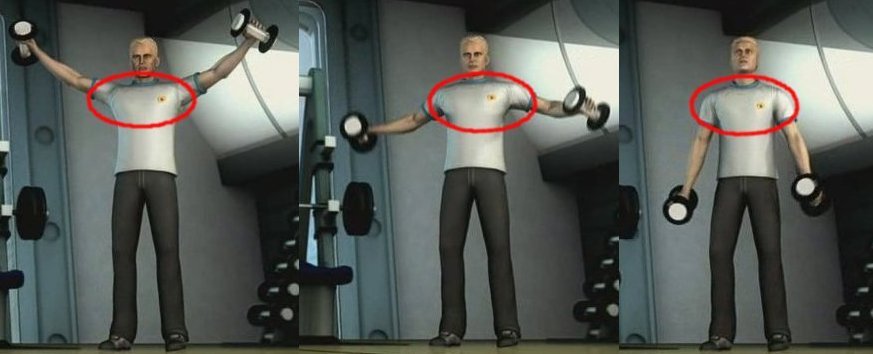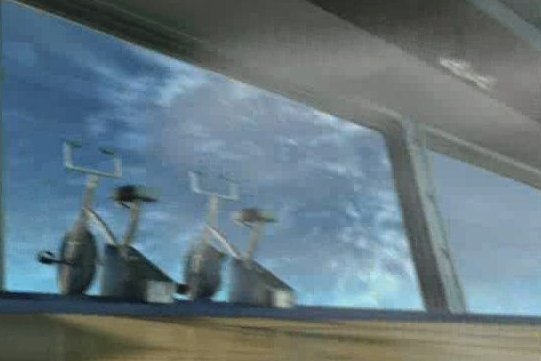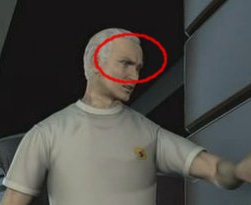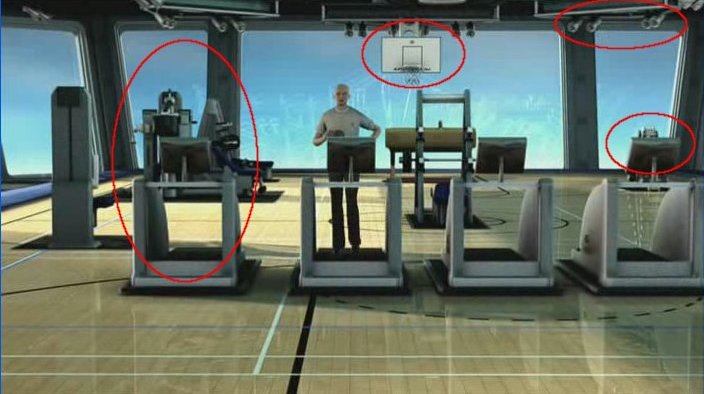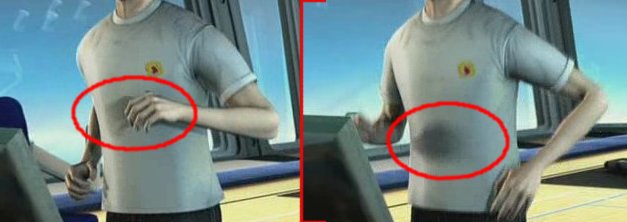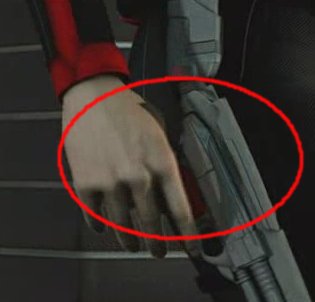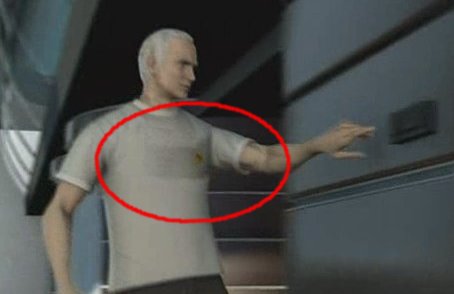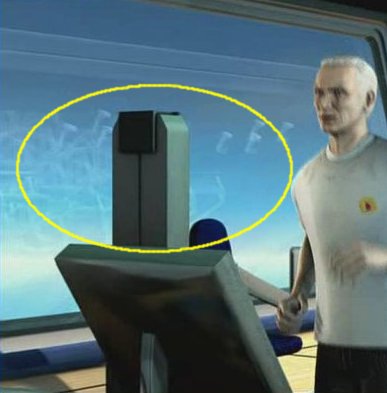Seeing Red
1 Introduction2 Timeline
3 Scene
3.1 Setting
4 Analysis
Shot: Captain Blue lifting
dumbbells
Shot: Colonel White On The Tread Mill
Shot: Shattering Glass and Air Suction
5 ConclusionShot: Colonel White On The Tread Mill
Shot: Shattering Glass and Air Suction
1 Introduction
This essay critiques the Computer Animation and Graphics used in a segment of Gerry Anderson's New Captain Scarlet episode. The segment is taken from episode 11 of season 2 which is titled Shape Shifter.2 Timeline
The critique refers to the video in the time line 8:51– 9:21s3 Scene
3.1 Setting
The scene is set in a gym in Skybase. The gym is shown to have a variety of exercise equipment like tread mills, cycles, steppers, benches and so on. There is also a basketball court. The room has glass walls all around it.3.2 Characters
Colonel White, Captain Blue and Mysteron masked as Captain Scarlet.3.3 Description
Colonel White and Captain Blue are working out in the gym. Colonel White is running on a tread mill while Captain Blue is exercising using dumb bells. A Mysteron which has taken the shape of Captain Scarlet enters the gym. It tries to shoot Colonel White. Captain Blue runs over in time to stop it. The shot fired by the Mysteron misses Colonel White and shatters a glass door. This causes the air to rush out. The Mysteron gets sucked out of the door before the safety metal door closes in.4 Analysis
4.1 Shots
Shot: Captain Blue lifting dumbbells
In this shot, Captain Blue is show to be exercising with dumb bells. Captain Blue's movements are animated using motion captured data. This makes the actual physical movements of the arms look quite realistic. There is reasonable detail in the movements. The person whose motion was captured gave realistic movement to the arms and torso. There is reasonable amount of secondary motion. For instance, the character moves its head down up and down. There is some movement of the chest and the lower part of the body.Motion capture and sound effects are just about what has been tried to make the shot realistic. However, this simple mapping of the motion capture to Captain Blue fails to look realistic in the final composition. This is mainly due to lack of some obvious details which we expect to see when a person is doing something that is physically straining. To make the scene look more realistic, the following improvements could have been made
(a) Incorporating Chest Movements
The most important phenomenon occurring when exercising, is the air inhalation and exhalation process. The chest moves in and out as the person breaths heavily during an exercise sessions, especially with dumbbells. This could have been easily incorporated into the scene in multiple ways [Fig 1]Fig1: No movement in chest of the character
Muscle animation: To bring the animation closer to reality, the character's chest muscles could have been animated in the scene. Accurate muscle animation which is a complex study is really not required here. A very simple animation would have sufficed. However, in the entire episode, I did not find any of the characters displaying muscle animation. So I conclude that there is no modeling of muscles for the characters. So this fix may not be the best suggestion.
Mesh Deformation: Mesh deformation is a inexpensive and easy to implement. Here, the character's shirt, could have been easily deformed dynamically in the scene to reflect the movement of the chest.
Animated Textures: The shirt of the character here is certainly mapped with some textures to show folds in the cloth. Although this does not look very realistic, it is easy and fast to implement. These textures could have been made in more detail to show the shape of the chest. Animated textures are easy to create and carefully created textures can be a quick fix to add a little more realism into the animation.
(b) Adding Muscle Movements to Arms
As the character lifts the weights up and down, the arms move as rigid objects. To make this look realistic, the muscles should contract and expand. As discussed above, since the characters display no muscle animation, this contacting and expanding can be simulated by dynamically deforming the mesh. Maybe a simply non-uniform scaling of the mesh in 3 dimensions can give a reasonable output.Shot: Colonel White On The Tread Mill
In this scene, Colonel White is running on a tread mill. This is shown in three different three shots with varying detail. In one, the legs are shown in close up. In second shot, the Colonel's torso is shown in close up. The third shot is a long one showing the complete character running on the tread mill. [Fig 2]Fig 2: Colonel White runs on the tread mill effortlessly
The motion capture used in these shots fails to win the scene any credits. In these shots too, like the previous described shots, the motion capture data seems to have been directly mapped to the model. There are no secondary effects/motion to bring realism to the scene which makes it look quite wrong.
In the shots, it looks as if Colonel White is running almost effortlessly on the tread mill. This is the major factor which makes the scene look unrealistic. The scene needs to display more effort being expended by the character.
Some additional effects which could have made the scene look more credible are described below.
(a) Show Sweating
The camera is quite close to the Colonel for a considerable amount of time. So it would have been worthwhile to show the Colonel to be sweating as he is running on the tread mill. There are two things which could have been done. One is to show sweat dripping down and the other is to show sweat on his clothes. Sweat on the clothes can easily be shown by creating patches on the shirt texture to show areas which are wet because of the sweat. The texture used for the face can also have droplets of sweat. To make the sweat more realistic, a very simple particle system can be implemented which emit droplets of sweat off the face, neck and muscles.(b) Display Friction
Friction of the tread mill is an important factor in making the running motion look realistic. For some reason, the motion capture for this scene displays practically no friction. It looks as if the Colonel is sliding effortlessly on the tread mill. The scene maybe better done with a motion capture sequence which was done on a real tread mill with higher difficulty level set on the tread mill setting when capturing the motion.A not-so-straight forward solution maybe to model the tread mill surface to emit frictional forces. These forces should act in the direction opposite to the tread mill motion. The forces will act to decelerate/retard the motion of the character.
Shot: Shattering Glass and Air Suction
The shot fired by the Mysteron impersonating Captain Scarlet shatters a glass wall and the air is sucked out. This scene looks very good. One major reason being good cinematography. The motion capture of all the stunts in this sequence fits in well into the scene. The drama and action are brought well into the scene.Shattering Glass
When the bullet strikes the glass wall, it shatters it into pieces. This shattering is done is good amount of detail making it very believable. The bullet shown as a spark of red light reflects off the glass as it strikes it as shown in Fig 3-a. Then the glass breaks to pieces. This breaking is close to how glass breaks when a fast moving object strikes against it. Once the glass breaks, the flying of pieces are not shown in great detail. This scene was most probably animated using a combination of textures and flying particles. Fig 3-b which shows the bullet impact maybe a texture. The flying of particles thereafter could have been a system of glass particles which fly off in the direction of a force (wind).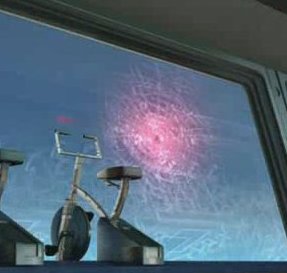 |
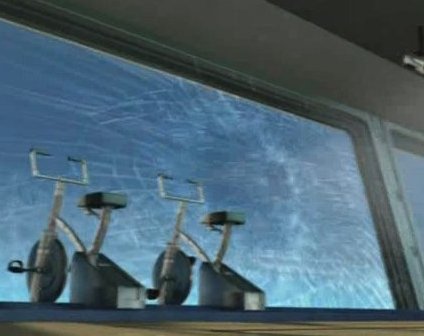 |
| Fig 3-a: Impact of Bullet | Fig 3-b: Shattering of Glass Wall |
Air Suction
When the glass wall breaks, the air in the room gets sucked out of the room rapidly. This may have been simulated using a particle system. The air particles move rapidly in the given direction [Fig 3-c]. Their properties like color and so on do not change. There are waves and patterns as the air gets sucked out. The simulation has enough randomness to make believe a rapid air flow. This is done pretty well.Fig 3-c: Air Rapidly Flowing out of the room
Response of the Characters
The physical movements of the characters to the air flow is also done very well. As the air gets sucked out, the characters begin to slide on the floor and struggle to hold onto some object so that they do not fall off the room [Fig 3-d]. All the characters are animated using motion capture here which was done very well.Fig 3-d: Characters experiencing the air flow
4. 2 Cloth Simulation
For most part of the episode and maybe the series in general, the Spectrum agents are uniformed. The uniform has the characteristic of holding tight onto the skin. The bullet shield wore is also pretty rigid. Hence, in most scenes, realistic looking cloth simulation was rightly not attempted. This worked well, but in this particular scene where Colonel White and Captain Blue are wearing casual clothes in the gym. They wear regular t-shirts which display characteristics like folding, stretching, wrinkling. They also unique motion as the character moves.In this scene, no kind of simulation seems to have been attempted. Effect of cloth folding is achieved by mapping textures onto the shirt with ridges, lines and shades [Fig 4]. Overall, the method does not give very realistic effects. The shirts look pretty rigid and stuck to the body. The loose edges do not move freely.
Fig 4: Cloth Characteristics Are Shown Through Textures
A possible way of simulating movements of the cloth may have been to deform the shirt mesh based on the velocity of the character. As the velocity of the character changes, the loose ends or the edges of the cloth move in some kind of a pattern to make it look like a non-rigid object.
4.3 Facial Animation
Apart from the movement of the lips to sync with the dialogs, there is a little although not significant amount of animation of the forehead and eyebrows. Of which, movement of the eyebrows is more perceptible. When the Mysteron takes out a revolver to shoot, anxiety in the face of Colonel White is shown with some forehead movements [Fig 5]. There is no perceptible movement of the eyes or the eyelids. In all, facial animation attempted in the scene is very limited.Fig 5: Wrinkles on Colonel White's Forehead
The techniques used in facial animation seems to be a combination of morphing and textures. Morphing is a way of deforming the actual mesh in complex manner. Textures are an easy way of showing wrinkles and other detail on the skin.
4.4 Environment
Objects
The environment is fairly rich with a number of objects. A variety of exercising equipment appear in the background. There are tread mills, exercise cycles, chest presses, dumbbell anchors and other similar looking objects. There is also a basketball court with flood lights.The objects are done in fair amount of detail. The models look realistic and make the setting look more believable. [Fig 6-a]
Fig 6-a: Setting With a Variety of Objects
Lights
The room is well lit with a number of local lights. The room is made of glass walls through which the outside atmosphere can be seen. This means that the diffuse light from the atmosphere affects the lighting in the room. This was done pretty well as the scene looks bright with the effect of lights turned on in the daylight.Shadows
Shadows appear everywhere. Almost all the objects in the scene cast shadows. The static objects make believable shadows. However, the characters cast shadows which are totally unrealistic. They do not correspond in any way to the direction of the light sources. Although they give the required 3D effect, the physics is totally incorrect. Although there are multiple light sources with different properties, there are no multiple shadows in the scene.In Fig 6-b we that as Colonel White's hands move alternately, both his hands cast a shadow on his shirt which means there are light sources to both his left and right. To his right, there is a glass wall through which daylight is entering the room, but from his left, it is not clear where the light is emerging from.
Fig 6-b: Shadows are cast from opposite directions although there are no visible light sources
As the Mysteron Captain Scarlet enters the scene, picking up his revolver, his hand cast a shadow. Here again, the light sources are not obvious [Fig 6-c].
Fig 6-c: Shadow of Character's Hand on the Revolver
In this shot [Fig 6-d], we see that the shadow of Colonel White's hand appears on his shirt while he is standing against an opaque wall!
Fig 6-d: No Light Source, But Character's Hand Casts Shadow
The shadows seem to have been programmed with not the physics, but the overall appeal and 3D effect in mind.
Reflections
The room in the scene has a shiny wooden floor. This must be to model the basketball court. The equipment and characters cast reflections on this surface, which look very good and makes the scene look rich and complex [Fig 7-a].Fig 7-a: Reflections Modelled Very Well
The walls seem to be made of some kind of thick glass. They have a high reflection component ans we see reflections of the objects in the room [Fig 7-b]. They also refract light from the atmosphere. Since Skybase is anchored far off in the upper atmospheric layers, the blue background looks apt. The textures are done well and blend into the scene. The roof and door are made of metal and also show good reflectance properties. The reflections may have been done using environment mapping of textures.
Fig 7-b: Glass Walls Reflect the Interior
5 Conclusion
The environment used in the scene is made in fair amount of detail. The surfaces, textures and lighting used in the scene creates a good overall environment although not physically accurate. Attention has been paid to reflections and material properties. Shadows are not accurate and do not correspond to the light sources in any way. They seem to have been programmed to give 3D effect by casting on a surface in a direction which looks the best in that scene.Motion capture is one of the major animation components used in the scene. The scene involves a lot action which was done using motion capture. There is some amount, although not the best, facial animation of the characters. There is no animation of clothes in the scene. The shattering of glass, breaking into pieces and rapid flow of air was well credibly.
